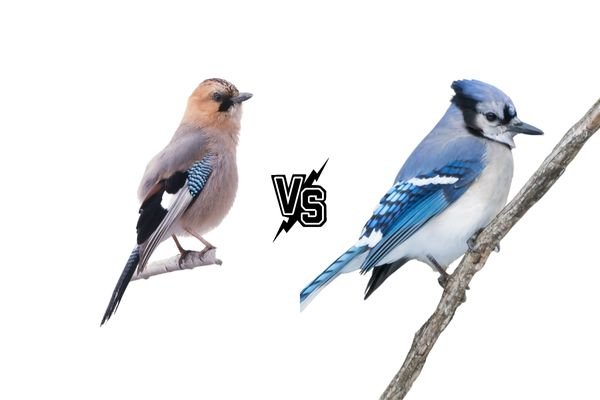All about Birds
What Do Blue Jays Eat? A Comprehensive Guide to Their Diet
What do Blue Jays eat?
This guide will reveal all…
In this blog post, we’ll take a close look at what Blue Jays eat, their eating habits and how they get their food.
What Do Blue Jays Eat?
Blue jays are omnivorous birds, which means they eat both plant and animal-based foods.
Their diet consists of seeds, nuts, fruits, insects, and small animals such as snails, caterpillars, and spiders.
Quick stats:
| Food Type | Examples |
|---|---|
| Seeds | Sunflower seeds, peanuts, acorns, corn, oats, wheat |
| Nuts | Hazelnuts, almonds, pecans, walnuts |
| Fruits | Apples, berries, cherries, grapes, oranges, figs, mulberries |
| Insects | Grasshoppers, caterpillars, beetles, ants, spiders |
| Other | Eggs, small vertebrates, carrion, pet food |
Seeds and Nuts
Blue jays are known for their love of nuts and seeds, which make up a significant portion of their diet.
Some of their favorite seeds include acorns, beech nuts, and sunflower seeds.
Blue jays have a unique ability to store food in their throat pouches, allowing them to carry and store seeds for later consumption.
Fruits
Blue jays also enjoy eating a variety of fruits, including wild berries, cherries, and grapes.
In the summer months, they often feed on fruit from trees, such as apple and pear trees. They are also known to enjoy fruit from bird feeders.
Insects and Small Animals
In addition to seeds and fruits, blue jays also eat a variety of insects and small animals. They will feed on snails, caterpillars, grasshoppers, and spiders.
Blue jays have even been observed eating small rodents such as mice and voles.
Feeding Habits
Blue jays are opportunistic feeders and will eat whatever is available.
They are also known for their aggressive behavior when it comes to food, often driving away other birds from feeders or food sources.
Blue jays have a unique feeding habit of using their beaks to crack open nuts and seeds.
They will also use their beaks to extract insects from tree bark.
Blue Jays Steal Food
Did you know that blue jays are also known to steal food from other birds?
They have been observed taking food from woodpecker holes and even stealing peanuts from squirrels.
Blue jays also have a unique vocalization when it comes to food.
They will often make a “rustling” sound with their wings when they find a food source. This noise alerts other blue jays in the area that food is available.
Blue jays are also known to cache food, which means they hide food in various locations to consume later.
They have excellent spatial memory and can remember the location of their hidden food for up to six months.
What do baby blue jays eat?
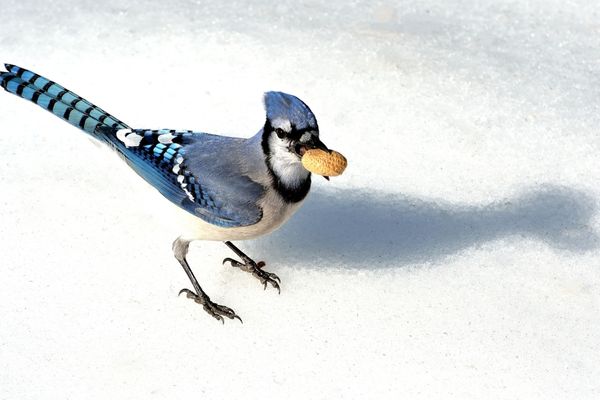
When it comes to feeding their young, mother blue jays are not picky eaters.
In fact, they will often feed their chicks whatever they can find, including insects, berries, and even other small animals.
This variety helps to ensure that the chicks get the nutrients they need to grow and thrive.Interestingly, baby blue jays have a very different diet than their adult counterparts.
Adult blue jays primarily eat seeds and nuts, but chicks are mostly carnivores.
| Food Type | Description |
|---|---|
| Insects | Baby blue jays primarily feed on insects, such as caterpillars, grasshoppers, beetles, and spiders. |
| Fruit | Blue jay fledglings also eat fruit, including berries, cherries, and grapes. |
| Seeds | As they grow, baby blue jays begin to eat seeds, such as sunflower seeds and peanuts. |
| Nuts | Blue jay chicks will also eat nuts, such as acorns and walnuts. |
| Protein-rich food | Occasionally, blue jay nestlings will eat small reptiles, amphibians, and even other birds’ eggs or nestlings. |
This is because their beaks are not yet strong enough to crack open hard shells. As a result, they must rely on softer foods that are easy to digest.
Over time, as their beaks grow stronger, baby blue jays will gradually transition to a more omnivorous diet.
What do blue jays drink?
Baby blue jays are born blind and helpless, but within a few weeks they’re fully feathered and ready to fledge.
During this time, they’re dependent on their parents for food.
This table breaks down exactly what Blue Jays drink:
| Type of drink | Description |
|---|---|
| Water | Blue jays primarily drink water to stay hydrated. They may drink from birdbaths, ponds, streams, or other sources of fresh water. |
| Sap | Blue jays also drink sap from trees, especially during the early spring when the sap is flowing. They use their sharp beaks to create small holes in the bark of the tree, allowing the sap to flow out, and then they drink it up. |
| Nectar | Blue jays have been known to drink nectar from flowers, although it is not a significant part of their diet. They may occasionally visit feeders with nectar or sugar water. |
| Juice | Blue jays may occasionally drink fruit juice, especially if it is offered to them in a bird feeder. However, this is not a significant part of their diet. |
| Milk | Blue jays do not drink milk, as they are lactose intolerant and cannot digest it properly. |
Both mom and dad feed their young by regurgitating semi-digested insects and other prey.
Once the fledgling period is over and the young birds strike out on their own, their diet starts to change.
Adult blue jays typically eat a varied diet of nuts, seeds, fruits, and insects.
But what do they drink?
In the wild, blue jays get the majority of the water they need from the food they eat.
Fruits and insects are particularly high in water content, and nuts contain enough moisture to keep blue jays hydrated.
Of course, blue jays also visit water sources to drink and bathe.
If you have a birdbath in your yard, there’s a good chance you’ve seen a blue jay taking a dip!
Blue Jay Habits and Biology
Blue jays are a common sight in many parts of North America, known for their striking blue plumage and loud calls.
These medium-sized birds are part of the crow family, and are known for their intelligent behavior and willingness to adapt to different environments.
Mating
Blue jays typically mate for life, and both parents help to raise their young.
Baby blue jays are born blind and helpless, but they grow quickly, fledging after only about three weeks.
During this time, they are fed a diet of soft food brought by their parents.
Diet
This diet gradually changes as the chicks grow older, until they are able to eat the same foods as their parents.
Blue jays typically live for around 10-15 years in the wild, though captive birds have been known to live for much longer.
These beautiful and fascinating birds play an important role in many ecosystems, and provide enjoyment for birdwatchers across the continent.
8 facts about Blue Jays
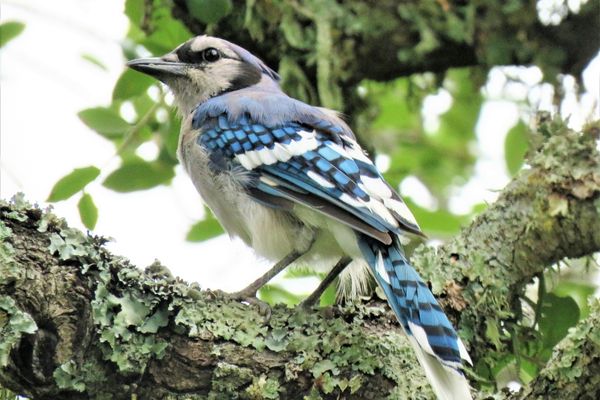
1. Blue Jays are omnivores, meaning they eat both plants and meat. They feed on seeds, berries, insects, small amphibians, reptiles and eggs of other birds.
2. The most common foods that Blue Jays consume are acorns, beechnuts, hickory nuts and walnuts which make up around 70 percent of their diet.
3. They also eat fruits and vegetables such as apples, cherries, blueberries, corn and tomatoes when in season.
4. Blue Jays will hunt for food by scouring the ground beneath trees for insects, or reaching into crevices to pull out spiders and worms. They will also eat smaller rodents and baby birds.
5. They can be seen catching insects in mid-air, and will often fly to nearby bird feeders to snatch up seeds that have been left out for them.
6. Blue Jays will store extra food in tree crevices or on the ground for later consumption. They will also bury their food, and then come back to it at a later time when hungry.
7. Blue Jays have even been known to bluff their way into other birds’ nests by pretending to be predators in order to steal eggs or chicks.
8. In the winter months, Blue Jays can survive on a diet of sunflower seeds, suet, peanuts and other birdseed that can be found in backyard feeders.
No matter what season it is, Blue Jays always have plenty of food sources to choose from. This makes them a great addition to any backyard!
Do blue jays eat other birds?
Yes, blue jays are known to be aggressive birds and can sometimes eat other smaller birds.
They usually prefer to consume insects but have been known to catch small birds if they cannot find an alternate food source.
In addition to eating other birds, blue jays are also omnivorous, meaning that they will eat both plant-based and animal-based foods.
They enjoy eating nuts, fruits, seeds, and berries, as well as insects such as caterpillars and grasshoppers.
Blue jays will also scavenge for food in the wild. This means that they’ll eat things like eggs, lizards, frogs, mice, small snakes, and even carrion (dead animals).
Blue jays also feed on suet, which is often sold in bird-feeding stores.
Suet contains a mix of fat and seeds that blue jays find quite tasty. It’s a great addition to any blue jay’s diet and can help attract them to your backyard.
Do blue jays eat snakes?
Blue jays are known for their bold colors and distinctive call, but they are also skilled predators.
These birds will eat a wide variety of prey, including insects, small mammals, and even other birds.
Given their carnivorous diet, it’s not surprising that blue jays have also been known to eat snakes.
While snakes may not be a preferred food source, blue jays will take advantage of an easy meal if they come across one. In fact, there have even been reports of blue jays attacking and killing venomous snakes, such as rattlesnakes.
So, while blue jays typically don’t seek out snakes as food, they are definitely not afraid to take one down if the opportunity presents itself.
What can I feed wild blue jays?
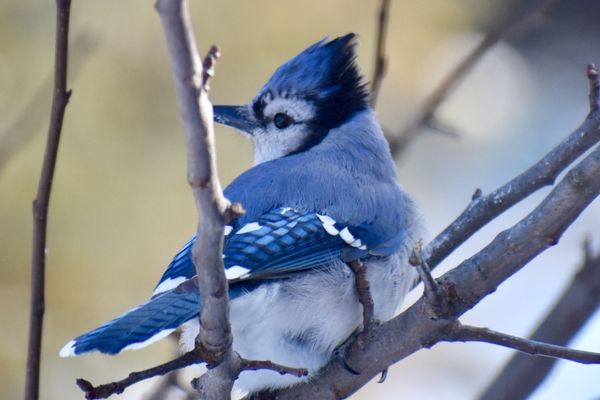
Wild blue jays are omnivorous birds that can eat a wide variety of foods. In the wild, they primarily feed on insects, but they will also eat nuts, berries, and other small fruits.
If you’re hoping to attract blue jays to your backyard, you can try offering them a variety of different foods.
Suet is a popular option, as blue jays love fatty foods. You can also offer them birdseed mixes, chopped peanuts, or pieces of fruit.
Keep in mind that blue jays are attracted to brightly colored objects, so try to use colorful feeders and birdhouses to attract their attention.
With a little patience and some trial and error, you should be able to find the perfect food to lure wild blue jays to your backyard.
Conclusion
Blue Jays are omnivores and feed on a wide variety of food items in the wild. They eat fruits, nuts, insects, small animals, grains, eggs, and garbage.
As backyard birds they can be fed sunflower seeds, peanuts, mealworms and suet.
Blue Jays also enjoy birdseed mixes that contain cracked corn or millet.
Provide a birdbath in addition to food for them and you may be rewarded by their presence in your yard.
FAQS
Do blue jays eat from bird feeders?
Yes! Like many other backyard birds, blue jays can often be seen at bird feeders. However, they do tend to prefer more natural foods such as insects and fruits. Therefore, if you want to attract them to your feeder, offer a variety of both seed and fruit-based treats.
Do Blue Jays eat bananas?
Blue Jays are one of the many bird species that enjoy eating bananas. In the wild, Blue Jays typically eat a diet of insects and small mammals. However, they will also eat fruits and nuts, including bananas. Bananas are a good source of carbohydrates and potassium for birds.
They are also relatively easy to digest. While Blue Jays do not necessarily need bananas in their diet, they can certainly benefit from the nutrients that they provide. If you see a Blue Jay eating a banana, it is likely that the bird is doing so for nutritional reasons.
What bird seed do blue jays like?

While blue jays will eat a variety of food, they have a particular fondness for bird seed. Their favorite type of seed is sunflower seeds, which they will often hoard in large quantities. They will also eat peanuts, millet, and corn.
In the wild, blue jays typically eat acorns and other nuts, as well as insects, berries, and fruits.
However, they will adapt their diet to whatever food is available, making them one of the most versatile birds in North America. So if you’re looking to attract blue jays to your backyard birdfeeder, be sure to include sunflower seeds in your mix.
What are Blue Jays favorite food?
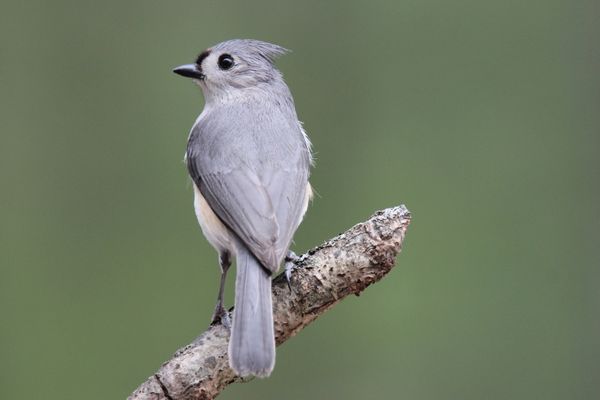
Blue jays are one of the most commonly seen birds in North America. They are known for their bright blue plumage and their loud, distinctive calls. But what do these vibrant birds eat? Blue jays are primarily carnivorous, meaning that they mostly eat other animals.
However, they will also eat fruits and nuts when available. Their diet consists mostly of insects, such as beetles and grasshoppers.
They also eat small mammals, such as mice and voles. In addition to meat, blue jays also consume a variety of plant foods, including acorns, berries, and seeds.
While they have a wide range of food preferences, blue jays typically prefer foods that are high in fat and protein. This helps them to maintain their high metabolism and active lifestyle.

